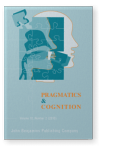Vol. 18:2 (2010) ► pp.423–441
Cooperation and competition in apes and humans
A comparative and pragmatic approach to human uniqueness
In Why We Cooperate (2009), Tomasello addresses the problem of human uniqueness, which has become the focus for a lot of recent research at the frontier between the Humanities and the Life Sciences. Being both a developmental psychologist and a primatologist, Tomasello is especially well suited to tackle the subject, and the present book is the most recent one in a series of books and papers by himself and his colleagues (see below). Tomasello’s basic position is squarely a dual-inheritance account, in which human uniqueness is explained both through genetics and through culture (in other words, both through natural and through cultural evolution). The main idea is that the phylogenetic specificity of humankind rests in its species-specific adaptation for sociability. The account offered by Tomasello contrasts human cooperation and altruism with nonhuman primate competition, and proposes that human altruism leads to shared intentionality (the ability to share attention to a third object and, more generally, to share beliefs and intentions). The evolutionary explanation Tomasello offers is that human ancestors were led through some kind of selection pressure to common foraging leading to collaboration and sharing. After outlining Tomasello’s position as it is described in the book, as well as the comments by Dweck, Spelke, Silk, and Skyrms which follow, I discuss Tomasello’s thesis, noting a few problems with his approach. These criticisms are based on his own work and on a number of his own other books and papers, as well as on other relevant work in the domain.
Cited by (2)
Cited by 2 other publications
This list is based on CrossRef data as of 10 july 2024. Please note that it may not be complete. Sources presented here have been supplied by the respective publishers. Any errors therein should be reported to them.
